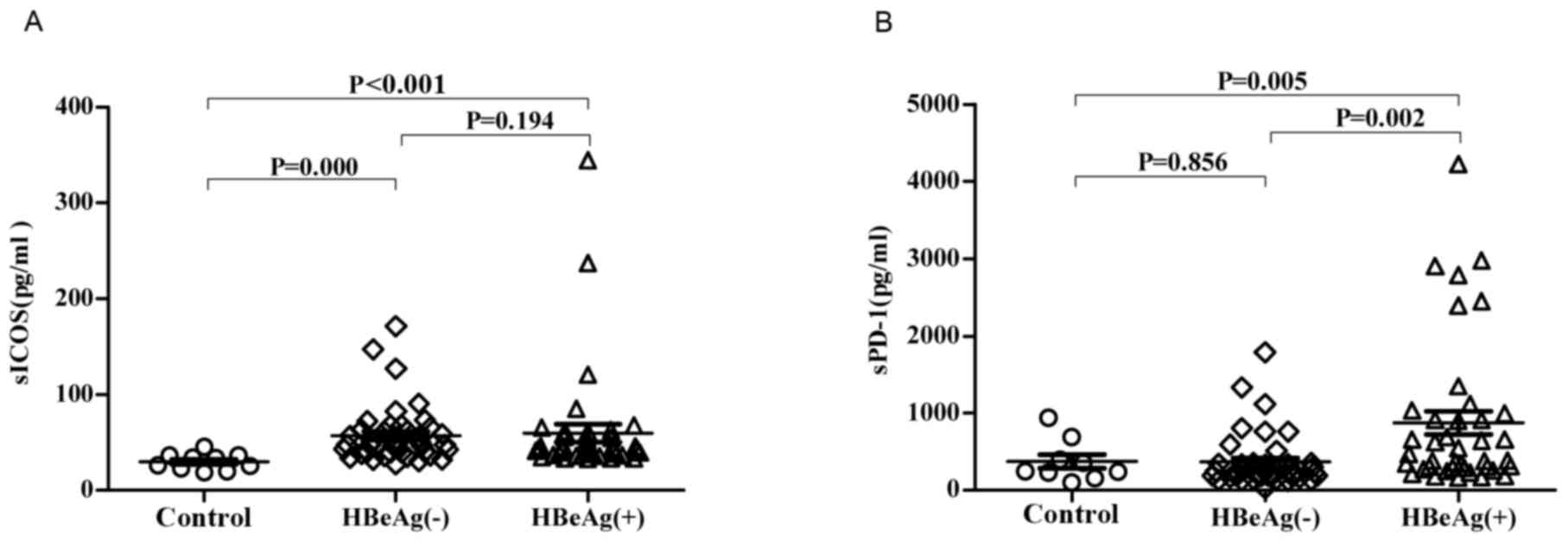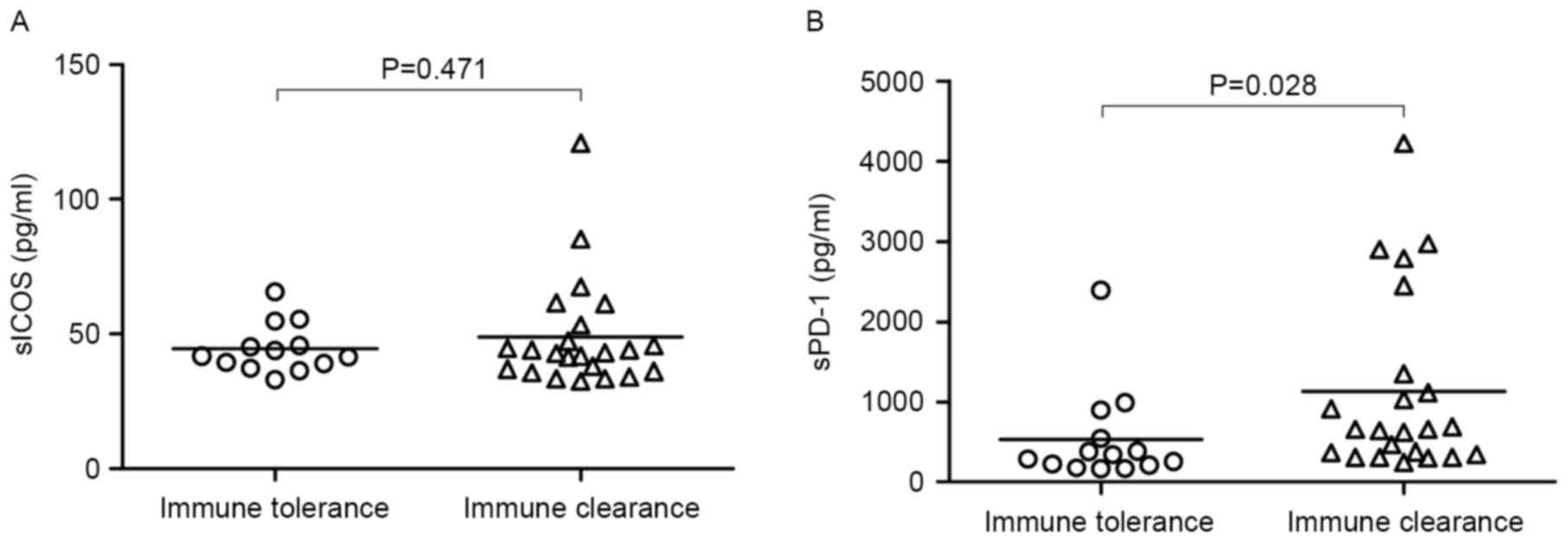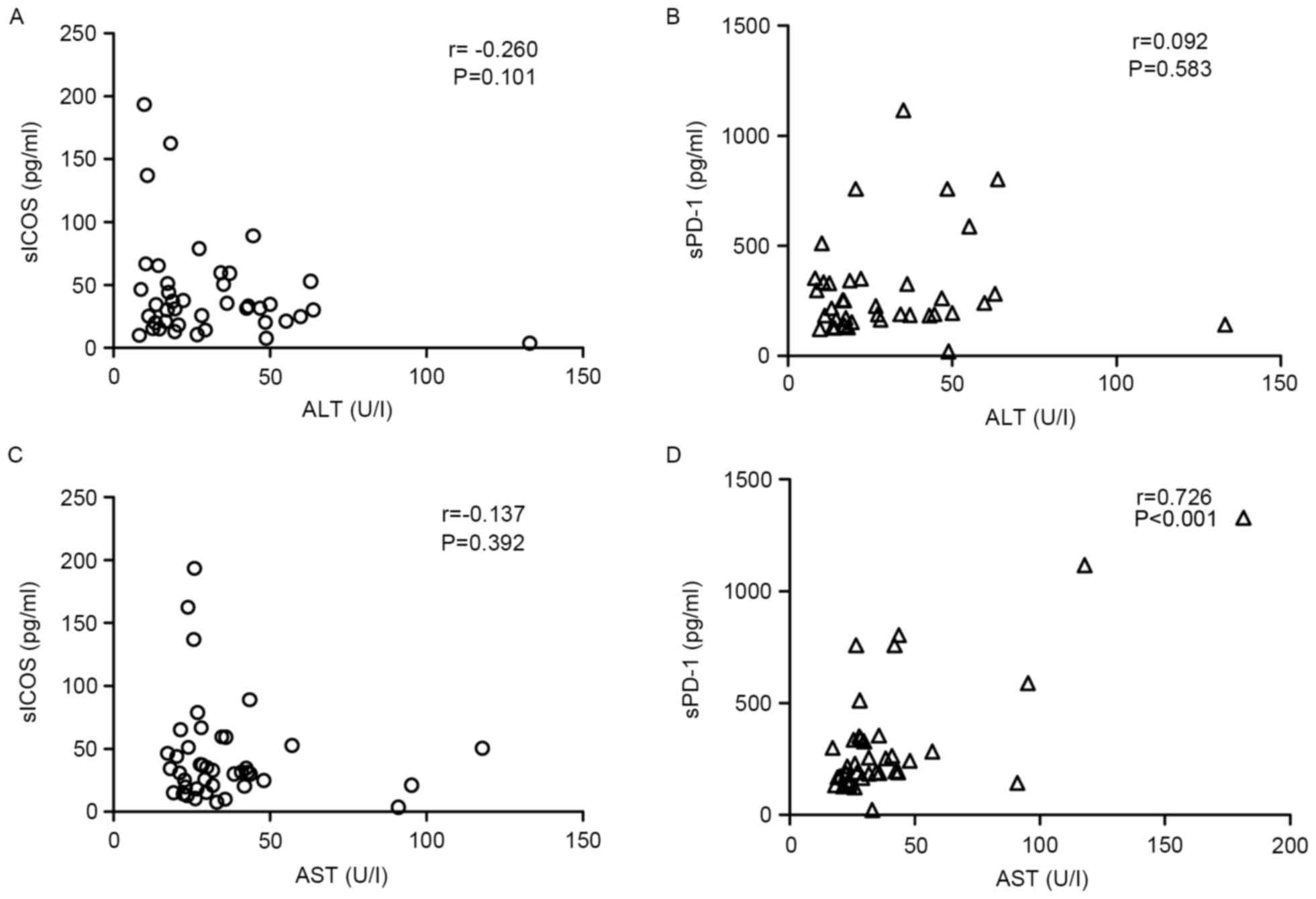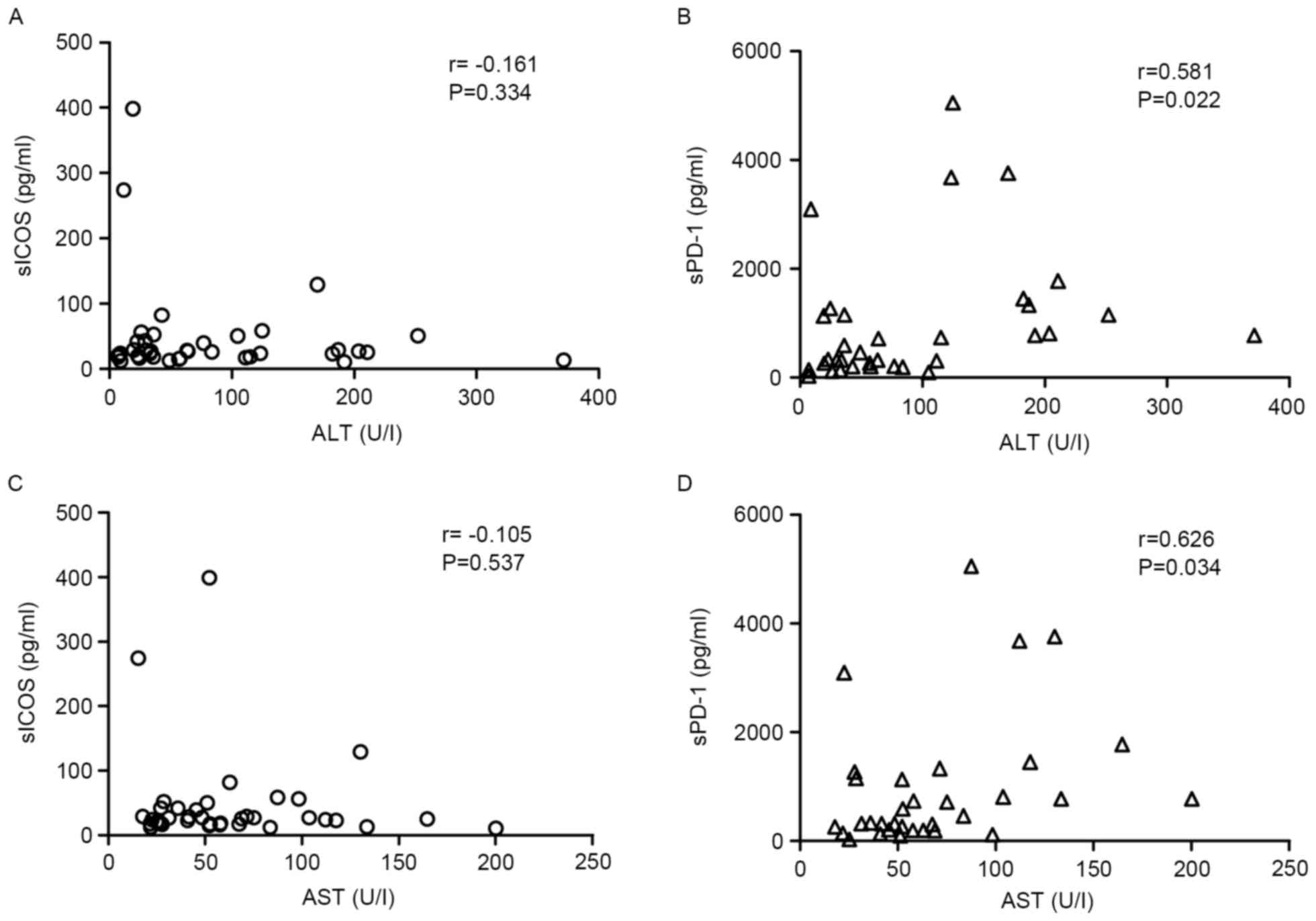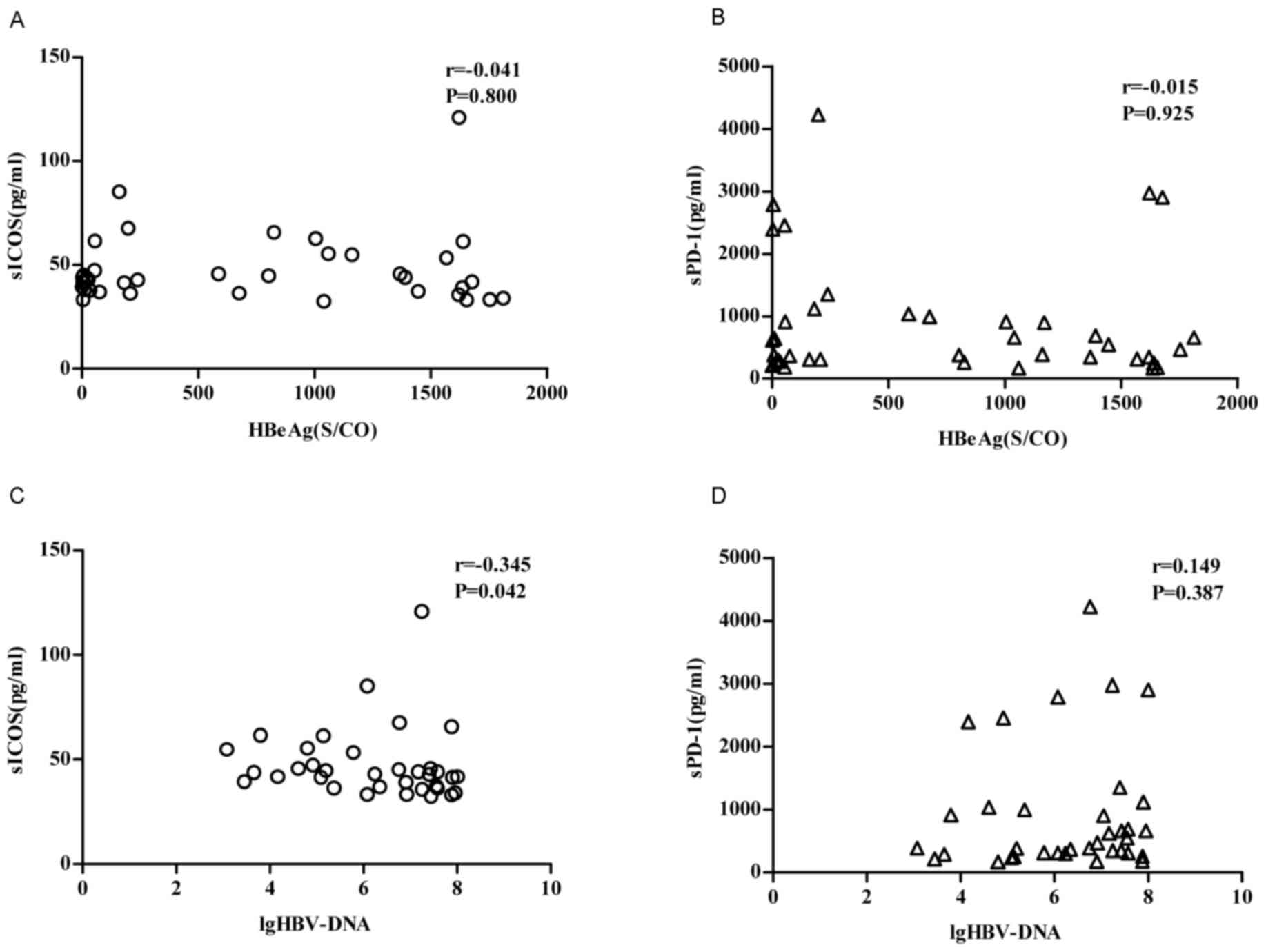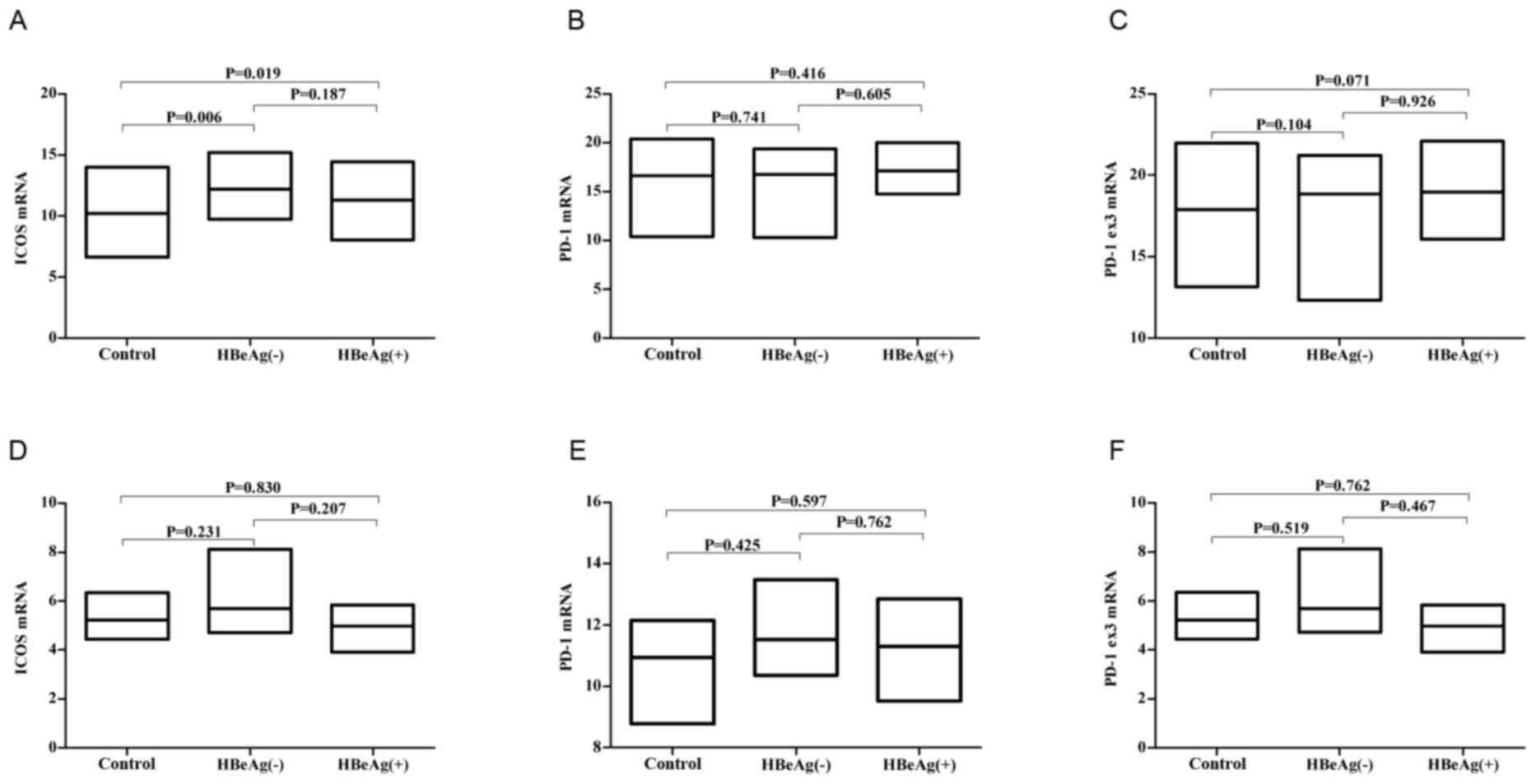Aberrant production of soluble inducible T cell co‑stimulator and soluble programmed cell death protein 1 in patients with chronic hepatitis B
- Authors:
- Published online on: September 26, 2017 https://doi.org/10.3892/mmr.2017.7630
- Pages: 8556-8562
Abstract
Introduction
Worldwide, >350 million individuals are infected with hepatitis B virus (HBV) and of those, ~1 million succumb to liver cirrhosis, hepatitis or liver carcinoma (1). It is well known that the interaction between the HBV and the host immune cells is crucial for determining the clinical outcome. The cellular immune response induced by the HBV is the main way the virus is cleared, and the level of response produced is also the deciding factor in whether a balance will be kept between viral replication and the immune system. Immune regulation is one of the most important factors of the anti-viral effect of the immune response (2,3). Once infected with HBV, antigen-presenting cells (APCs) present HBV antigens to naïve T cells by major histocompatibility complex molecules, which the activates T cells (4). In addition, a co-stimulatory signal is frequently required to make the T cells optimally active.
Co-stimulators can also exist in soluble forms. Soluble (s) cluster of differentiation (CD)80, CD86, CD28 and cytotoxic T-lymphocyte protein 4 (CTLA-4) were aberrantly expressed in patients with chronic hepatitis B (5,6). The expression of CD28 and CTLA-4 is involved in the pathogenesis of patients infected with HBV that develop hepatic carcinoma (7). Inducible co-stimulator molecule (ICOS) and programmed cell death protein 1 (PD-1) serve an important role in T cell activation. A previous study revealed that sICOS and sPD-1 are correlated with immune function and the activation of T cells (8). Their aberrant production may be associated with a number of different diseases. sICOS is significantly increased in diffuse sclerosis (9) and sPD-1 could promote T cell activation and enhance its anti-tumor effect (10). The present study aims to discuss the expression and effect of sICOS and sPD-1 in patients infected with HBV.
Previous studies have demonstrated that there are different isoforms of PD-1 as a result of alternative splicing of mRNA and soluble forms of PD-1 and ICOS are present in the circulation in order to maintain immune homeostasis. PD-1 and ICOS have been identified in a number of diseases including hepatitis C, rheumatoid arthritis and systemic lupus erythematosus (5,11,12). However, the clinical significance and immunological roles of ICOS and PD-1 in patients with HBV is unknown. The association of sPD-1 and sICOS with chronic HBV infection was investigated in the present study.
Materials and methods
Subjects
For the present study 80 patients with chronic HBV and 30 volunteers (normal controls) were recruited. The individuals with chronic HBV infections were patients from The Affiliated Hospital of North Sichuan Medical College (Sichuan, China) from August 2012 to May 2013. Patient characteristics are presented in Table I. All patients were positive for the HBV large envelope protein, positive or negative for HBV external core antigen (HBeAg), and negative for hepatitis C, hepatitis D virus and human immunodeficiency virus. All patients were without any other disease-associated liver damage. Patients with concomitant illness and autoimmune disease were excluded. No patients received anti-HBV agents or steroids one year prior to samples being obtained. Each individual gave written informed consent and the protocol was approved by the Clinical Research Ethics Committee of the Affiliated Hospital of North Sichuan Medical College.
Patients were divided into the HBeAg(+) group and the HBeAg(−) group. The HBeAg(+) group was divided into immune-clearance phase and immune-tolerance phase groups. Immune-clearance phase characteristics: HBsAg(+), HBeAg(+), HBV-DNA(+), serum alanine aminotransferase (ALT) and aspartate aminotransferase (AST) continuously or repeatedly raised, or liver histological examination revealed hepatitis lesions. Immune-tolerance phase characteristics: HBsAg(+), HBeAg(+), HBV DNA positive, but ALT and AST were in normal range, and liver histological examination generally revealed no obvious abnormalities.
Virus detection and biochemistry assays
The HBV associate indexes (HBsAg, HBsAb, HBeAg, HBeAb and HBcAb) were detected via Architect I2000sr immunology analyzer (Abbott Pharmaceutical Co., Ltd., Lake Bluff, IL, USA). The HBV DNA level was determined by reverse transcription-quantitative polymerase chain reaction (RT-qPCR) with hepatitis B virus nucleic acid determination kit (cat. no. 18441; Xiamen Kehua Hengsheng, Co., Ltd, Fujian, China), using the LightCycler® 480 System (Roche Diagnostics GmbH, Mannheim, Germany) with a detection sensitivity of 1×103 IU/ml. Cycling conditions included an initial denaturation of 2 min at 95°C followed by 40 cycles of 10 sec at 95°C and 30 sec at 60°C. Each sample was run in triplicate and averaged. Serum ALT and AST were measured by the Synchron LX20 auto-analyzer (Beckman Coulter, Inc., Brea, CA, USA).
ELISA for sICOS and sPD-1
The serum concentration of sICOS and sPD-1 in the patients with HBV and the control group was detected using ELISA kits (sICOS; cat. no. SEA777Hu, Cayman Chemical Company, Ann Arbor, MI, USA; sPD-1; cat. no. DY1086; R&D Systems, Inc., Minneapolis, MN, USA). The assay was conducted according to the manufacturer's protocol.
RT-qPCR
Peripheral blood mononuclear cells (PBMC) of HBV patients and the controls were obtained according to the manufacturer's protocol for the PBMCs separation medium (cat. no. LTS1077; Shanghai Haoyan Biotech Co., Ltd., Shanghai, China). Half of the PBMCs/patient were stimulated with 20 µg/ml phytohemagglutinin (Sigma-Aldrich; Merck KGaA, Darmstadt, Germany) and 1 µg/ml lipopolysaccharide (Sigma-Aldrich; Merck KGaA). RNA extraction was performed using Trizol reagent and cDNA synthesis with the iScript cDNA synthesis kit (Roche Diagnostics, Basel, Switzerland) was performed according to the manufacturer's protocol (Promega Corporation, Madison, WI, USA).
The following PCR primer sequences were used: Forward, 5′-GTTCCCTGAGTTGTTTG-3′ and reverse, 5′-TCATCTTGAGGTGTCCC-3′ for ICOS; forward, 5′-CCGCCTTCTGTAATGGTTTGA-3′ and reverse, 5′-GGGCAGCTGTATGATCTGGAA-3′ for PD-1; Forward 5′-GCTCAGGGTGACAGGGAC-3′ and reverse, 5′-CAATGGTGGCATACTCCGTCT-3′ for PD-1Δex3 (encoding sPD-1). GAPDH forward, 5′-CGGAGTCAACGGATTTGGTCGTAT-3′ and reverse, 5′-AGCCTTCTCCATGGTGGTGAAGAC-3′) was used as an internal control to normalize target mRNA levels.
The RT-qPCR was performed using SYBRGreen® (Roche Diagnostics) as detection system. The PCR reaction system (20 µl) consisted of the following: 0.4 µl of each pair primer (10 nM), 2 µl of template DNA, 10 µl of 2X SYBR-Green PCR master mix, and DNAse-RNse-free water to complete the final 20 µl volume. Cycling conditions were the same as used for HBV-DNA. Relative RNA levels were quantified using the 2−ΔΔCq formula (13).
Statistical analysis
The Kruskal-Wallis H test followed by bonferroni post-hoc test was used to analyze the difference in sPD-1 and sICOS levels between normal controls and patients. The Spearman's rank correlation coefficient was used to assess the correlation between sPD-1, sICOS, ALT, AST and HBV associate indexes. Results are expressed as the median and interquartile range. The data were analyzed with OriginPro statistical software (version 8.5; OriginLab, Northampton MA, USA). P<0.05 was considered to indicate a statistically significant difference.
Results
Serum concentration of sICOS and sPD-1 in patients with HBV and the controls
The concentrations of sICOS and sPD-1 in the HBeAg(+) group were increased compared with the control group (Fig. 1). There was no significant difference in the concentration of sICOS in the HBeAg(−) group compared with the HBeAg(+) group. The concentration of sPD-1 was significantly increased in the HBeAg(+) group compared with the HBeAg(−) group (P<0.05; Fig. 1B).
Serum concentration of sPD-1 and sICOS in the immune tolerance and immune clearance phases
sPD-1 in the immune clearance phase was significantly increased compared with the tolerance stage (P<0.05) however there was no significant difference in the concentration of sICOS between the different phases (Fig. 2). This indicates that sPD-1 is associated with the co-stimulators involved in the reaction to HBV. Their upregulation is not consistent with their receptor levels. This result is negatively correlated to CD8+ lymphocyte numbers (7,14).
Correlation of sPD-1 or sICOS with specific biochemical factors
Only sPD-1 demonstrated a positive correlation with AST in HBeAg(−) patients (r=0.726, P<0.01), whereas sICOS demonstrated no correlation with AST levels (Fig. 3). However, no correlation was observed between sICOS or sPD-1 levels and ALT in HBeAg(−) patients. In the HBeAg(+) group, sPD-1 exhibited a positive correlation with AST and ALT (r>0.5; P<0.05; Fig. 4).
Correlation of sPD-1 or sICOS with HBeAg levels and HBV-DNA levels
Only sICOS is poorly correlated with the log10 (lg10)-transformed value of HBV-DNA in patients with chronic HBV (P<0.05, r=-0.345), whereas there was no correlation with HBeAg. There was no correlation between sPD-1 and HBeAg levels/lg10-transformed value of HBV-DNA (P>0.05; Fig. 5).
ICOS, PD-1 and PD-1Δex3 mRNA levels in HBV patients' PBMCs cells
RT-qPCR demonstrated that the mRNA levels of ICOS in PBMC was elevated in patients with chronic HBV compared with the normal controls (Fig. 6A). Considering that sICOS may be shed from the membranes of these cells, the upregulation of these molecules may explain the high levels of ICOS in HBV patients. Whereas the mRNA levels of PD-1 and PD-1Δex3 (prior to and following stimulation) were no different compared with the normal controls (Fig. 6B, C, E and F).
Discussion
APCs activate T cells in response to a variety of signals. In patients with HBV, T cell activation is also important for clearance of the virus. Co-stimulatory signals influence the type of immune response and the intensity of the T cell activation process (2,3). T cell dysfunction and abnormal immunomodulation of molecules by APCs, in patients with HBV has previously been demonstrated (15). There are numerous co-stimulatory molecules, including CD28, CD80, CD86 and CTLA, all of which possess membrane-bound and soluble forms (16). sPD-1 and sICOS are formed by alternative mRNA splicing or shed from the membrane of T cells. The structure of ICOS is similar to CD28, and the two molecules are positive co-stimulators that activate T cells. PD-1 exhibits 23% homology with CTLA-4 and, may suppress or terminate immune cell proliferation and activation when combined with the PD-ligand 1 (L1) or PD-L2 (17,18). However to the best of the authors' knowledge, the soluble co-stimulatory molecules in patients with chronic HBV have not previously been investigated.
In the present study, it was demonstrated that the serum concentrations of sPD-1 and sICOS were elevated in HBeAg(+) patients compared with the normal controls. However in the HBeAg(−) group, only sICOS increased. The small sample size of the present study may have influenced the results and led to an incorrect conclusion being drawn. When patients were separated into immune tolerance and immune clearance groups, sPD-1 concentration significantly rose in the clearance phase indicating that PD-1 may be involved in the virus clearance process.
In the present study, sPD-1 and sICOS were upregulated in the HBeAg(+) group compared with the normal control. Although the function of sPD-1 and sICOS remains unknown the results of the present study indicate an immune regulatory function and this suggests that sPD-1 and sICOS may serve a role in the pathogenesis of HBV. The soluble form may interfere with the interaction between the two membrane bound forms and their ligands, which may lead to immune dysregulation and a defective immune response. Abnormal sICOS may compete with the ICOS-L to suppress T cell activation and in turn cause T cell exhaustion. PD-1 and PD-L has been demonstrated to negatively regulate the immune response in primary and secondary immune reactions (19,20). Therefore, the abnormal concentration of sPD-1 would enhance the antiviral effects.
However, in the HBeAg(−) group, only sICOS demonstrated a serious increase. In HBeAg(+) group, only sPD-1 is significantly elevated compared with the HBeAg(−) group, whereas there was no significant difference in sICOS. Considering the numbers of patients enrolled in the present study, this phenomenon requires further study. Different soluble co-stimulators do not exhibit the same function in different HBV patient groups.
Patients with HBV were divided into immune tolerance and clearance groups. sPD-1 and sICOS were elevated in the clearance group. The correlation between the levels of sPD-1 and sICOS, and clearance of the virus remains unclear and requires further investigation. However, it was observed that sPD-1 and sICOS concentrations may reflect the virus activity (3). In a PD-1 knock-out mouse, the negative immune regulation induced by PD-1 is important to immune tolerance. The extracellular domain of PD-1 specifically, could combine with its ligand and inhibit the interaction between PD-1/PD-L1, thus, maintaining immune homeostasis and enhancing T cell activity (21). In the present study, the upregulation of sPD-1 may prolong the life of HBV specific T cells. The elevation of these cells should aid HBV clearance by the immune system.
AST is frequently elevate in patients with active HBV infections, and it is also positively correlated with sPD-1, which demonstrates that sPD-1 is a useful molecular marker to reflect the degree of liver injury and viral activity. From the results of the present study, considering their weak immunomodulatory function, sPD-1 and sICOS frequently do not alter synchronously with other biochemical markers. As a result, the correlation is significant but weak.
As sPD-1, but not sICOS, has been demonstrated to be highly expressed in a number of diseases (22), sPD-1 may not be specific for chronic HBV infections. Additionally, sICOS has not been investigated previously. Therefore, these two markers are not necessarily disease-specific molecules. However, due to the correlation of sPD-1 and sICOS with the HBV DNA copies, the two molecules may be partially associated with viral replication and HBV pathogenesis, which may lead to the dysregulation of T-cell co-stimulation.
To investigate the generation of sPD-1and sICOS in patients with HBV, the expression of PD-1 and ICOS in PBMCs was detected with qPCR. This result is not consistent with the soluble forms of the molecules. This phenomenon may be explained by the different speed of shedding from the membrane or the different degradation speeds. As a result, the level of the soluble form is not proportional to the level of the membrane form.
As PD-1 and ICOS exist at a high level in the cell membrane, the soluble form may be shed and function as a regulator in certain physiological and pathology processes. Although the exact mechanism of how the soluble form is produced is not clear, its upregulation in HBeAg(+) patients rather than other subtypes may indicate a role in disease. Inhibiting PD-1/PD-1 L function could be a useful way to recover T cell function and induce T cell proliferation. In the present study, there was no significant difference between HBeAg(+) patients and the healthy controls.
In conclusion, to the best of the authors' knowledge the present study was the first to investigate the soluble form of co-stimulator in serum of patients with HBV. The high levels of sPD-1 and sICOS serve an important role in the pathological process of HBV infection. These soluble molecules may be novel therapeutic targets for HBV therapy. Further study should be carried out to investigate the role of sPD-1 and sICOS in HBV infection.
References
|
Lok AS: The maze of treatments for hepatitis B. N Engl J Med. 352:2743–2746. 2005. View Article : Google Scholar : PubMed/NCBI | |
|
Ferrari C: HBV and the immune response. Liver Int. 35 Suppl 1:S121–S128. 2015. View Article : Google Scholar | |
|
Lee JA, Kim YM, Hyun PM, Jeon JW, Park JK, Suh GH, Jung BG and Lee BJ: Honeybee (Apis mellifera) venom reinforces viral clearance during the early stage of infection with porcine reproductive and respiratory syndrome virus through the up-regulation of Th1-specific immune responses. Toxins (Basel). 7:1837–1853. 2015. View Article : Google Scholar : PubMed/NCBI | |
|
Klein J and Sato A: The HLA system. First of two parts. N Engl J Med. 343:702–709. 2000. View Article : Google Scholar : PubMed/NCBI | |
|
Wang D, Zhou D, DU Q, Liang Q, Wang Q, Fang L, Wang G, Fan Q, Liu B, Zhou J, et al: Aberrant production of soluble inducible T-cell co-stimulator (sICOS) and soluble programmed cell death protein 1 (sPD-1) in patients with chronic hepatitis C. Mol Med Rep. 7:1197–1202. 2013. View Article : Google Scholar : PubMed/NCBI | |
|
Cao J, Zhang L, Huang S, Chen P, Zou L, Chen H, Xiang Y, Lai X and Ren G: Aberrant production of soluble co-stimulatory molecules CTLA-4 and CD28 in patients with chronic hepatitis B. Microb Pathog. 51:262–267. 2011. View Article : Google Scholar : PubMed/NCBI | |
|
Wang L, Zhao C, Peng Q, Shi J and Gu G: Expression levels of CD28, CTLA-4, PD-1 and Tim-3 as novel indicators of T-cell immune function in patients with chronic hepatitis B virus infection. Biomed Rep. 2:270–274. 2014.PubMed/NCBI | |
|
Nurieva RI, Mei XM, Forbush K, Bevan MJ and Dong C: B7h is required for T cell activation, differentiation, and effector function. Proc Natl Acad Sci USA. 100:pp. 14163–14168. 2003; View Article : Google Scholar : PubMed/NCBI | |
|
Yanaba K, Asano Y, Noda S, Akamata K, Aozasa N, Taniguchi T, Takahashi T, Ichimura Y, Toyama T, Sumida H, et al: Increased production of soluble inducible costimulator in patients with diffuse cutaneous systemic sclerosis. Arch Dermatol Res. 305:17–23. 2013. View Article : Google Scholar : PubMed/NCBI | |
|
Wu X, Zhang H, Xing Q, Cui J, Li J, Li Y, Tan Y and Wang S: PD-1(+) CD8(+) T Cells are exhausted in tumours and functional in draining lymph nodes of colorectal cancer patients. Br J Cancer. 111:1391–1399. 2014. View Article : Google Scholar : PubMed/NCBI | |
|
Her M, Kim D, Oh M, Jeong H and Choi I: Increased expression of soluble inducible costimulator ligand (ICOSL) in patients with systemic lupus erythematosus. Lupus. 18:501–507. 2009. View Article : Google Scholar : PubMed/NCBI | |
|
Wan B, Nie H, Liu A, Feng G, He D, Xu R, Zhang Q, Dong C and Zhang JZ: Aberrant regulation of synovial T cell activation by soluble costimulatory molecules in rheumatoid arthritis. J Immunol. 177:8844–8850. 2006. View Article : Google Scholar : PubMed/NCBI | |
|
Livak KJ and Schmittgen TD: Analysis of relative gene expression data using real-time quantitative PCR and the 2(-Delta Delta C(T)) method. Method. 25:402–408. 2001. View Article : Google Scholar | |
|
Ye B, Liu X, Li X, Kong H, Tian L and Chen Y: T-cell exhaustion in chronic hepatitis B infection: Current knowledge and clinical significance. Cell Death Dis. 6:e16942015. View Article : Google Scholar : PubMed/NCBI | |
|
Bengsch B, Martin B and Thimme R: Restoration of HBV-specific CD8+ T cell function by PD-1 blockade in inactive carrier patients is linked to T cell differentiation. J Hepatol. 61:1212–1219. 2014. View Article : Google Scholar : PubMed/NCBI | |
|
Magistrelli G, Jeannin P, Elson G, Gauchat JF, Nguyen TN, Bonnefoy JY and Delneste Y: Identification of three alternatively spliced variants of human CD28 mRNA. Biochem Biophys Res Commun. 259:34–37. 1999. View Article : Google Scholar : PubMed/NCBI | |
|
Hutloff A, Dittrich AM, Beier KC, Eljaschewitsch B, Kraft R, Anagnostopoulos I and Kroczek RA: ICOS is an inducible T-cell co-stimulator structurally and functionally related to CD28. Nature. 397:263–266. 1999. View Article : Google Scholar : PubMed/NCBI | |
|
Ishida Y, Agata Y, Shibahara K and Honjo T: Induced expression of PD-1, a novel member of the immunoglobulin gene superfamily, upon programmed cell death. EMBO J. 11:3887–3895. 1992.PubMed/NCBI | |
|
Jiang W: Blockade of B7-H1 enhances dendritic cell-mediated T cell response and antiviral immunity in HBV transgenic mice. Vaccine. 30:758–766. 2012. View Article : Google Scholar : PubMed/NCBI | |
|
Shankar EM, Che KF, Messmer D, Lifson JD and Larsson M: Expression of a broad array of negative costimulatory molecules and Blimp-1 in T cells following priming by HIV-1 pulsed dendritic cells. Mol Med. 17:229–240. 2011. View Article : Google Scholar : PubMed/NCBI | |
|
Cheng HY, Kang PJ, Chuang YH, Wang YH, Jan MC, Wu CF, Lin CL, Liu CJ, Liaw YF, Lin SM, et al: Circulating programmed death-1 as a marker for sustained high hepatitis B viral load and risk of hepatocellular carcinoma. PLoS One. 9:e958702014. View Article : Google Scholar : PubMed/NCBI | |
|
Thio CL, Mosbruger TL, Kaslow RA, Karp CL, Strathdee SA, Vlahov D, O'Brien SJ, Astemborski J and Thomas DL: Cytotoxic T-lymphocyte antigen 4 gene and recovery from hepatitis B virus infection. J Virol. 78:11258–11262. 2004. View Article : Google Scholar : PubMed/NCBI |



